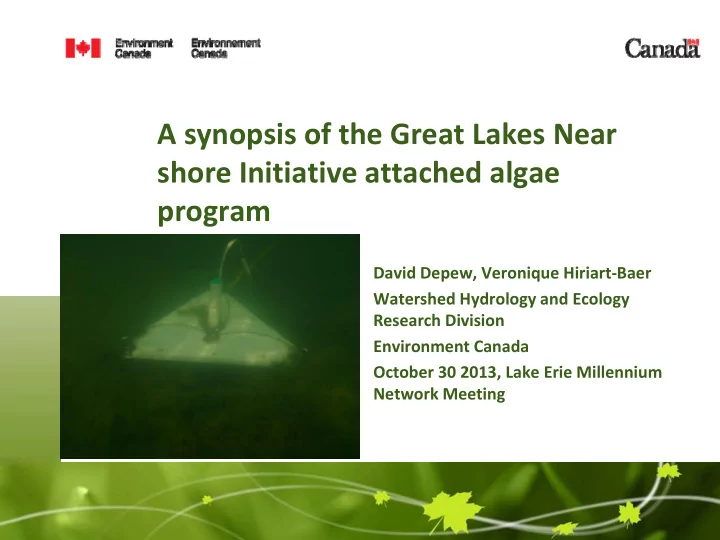

A synopsis of the Great Lakes Near shore Initiative attached algae program David Depew, Veronique Hiriart ‐ Baer Watershed Hydrology and Ecology Research Division Environment Canada October 30 2013, Lake Erie Millennium Network Meeting
Background Present 1970s 1980s 1990s 2000s • Implementation of GLWQA, beginning of point source P control • Dreissenid mussels invade L. Erie, P loads continue to decline • Blooms of Cladophora recur along north shore of E. L. Erie • Revival of Cladophora related research in E. L. Erie and elsewhere DRAFT – Page 2 – December 3, 2013
Background Rock Pt. Prov. Pk. 2006 Image: S Higgins Rathfon Pt. July 2013 Volume of algal material collected on DRAFT – Page 3 – December 3, 2013 Intake screens: OPG Pickering.
Soluble Reactive P levels (2 – 10 m) July – Aug 2005 Apr – May 2005 MDL = 0.35 µ g L -1 DRAFT – Page 4 – December 3, 2013
Present Status… • Benthic algal blooms continue to impair near shore water quality, habitat and recreational uses. • Near shore P levels not indicative of excessive nutrient loading. • Temporal trends not easy to identify. • Elucidation of causal factors has proven challenging, but evidence to ‐ date supports the role of dreissenid mussels as key agents of change. DRAFT – Page 5 – December 3, 2013
Key Question What, if any nutrient target(s) may provide reasonable protection of near shore regions from recurrent blooms of benthic algae? DRAFT – Page 6 – December 3, 2013
GLNI attached algae program objectives • Identify proximate sources of P contributing to nuisance blooms • Quantify P processes in and above dreissenid beds in Eastern Lake Erie (R. Smith, J. Majarreis, U Waterloo) • Reconstruct historical timeline of benthic algal resurgence in E. Lake Erie (K. Mueller, U Waterloo) DRAFT – Page 7 – December 3, 2013
Study Area DRAFT – Page 8 – December 3, 2013
Approach • δ 18 O PO4 to delineate P sources responsible for Cladophora blooms – SRP – Cladophora tissue – Dreissenid tissue – Dreissenid “wastes” • Use of other isotope based tracers (e.g., DOC 13 , 15 N 18 O 3 ) to constrain sources • Standard physical and chemical water quality metrics with quantitative benthic survey data DRAFT – Page 9 – December 3, 2013
δ 18 O – PO 4 Primer = O 18 H H H H = O 16 O O H H O H H H H H O H O O O O P O O P O O Enzyme mediated O exchange drives δ 18 O-PO 4 to equilibrium O O based on temperature DRAFT – Page 10 – December 3, 2013
δ 18 O – PO 4 of different P sources Do different P sources have different δ 18 O – PO 4 ? Fecal leachate WWTP effluent Aerosols Semi processed P ores Detergents Chemical fertilizers 7 8 9 10 11 12 13 14 15 16 17 18 19 20 21 22 23 24 25 26 δ 18 O P of potential P sources (Data from Young et al. 2009) DRAFT – Page 11 – December 3, 2013
δ 18 O – PO 4 in different freshwaters Does rapid P cycling overprint source signature too quickly? 6 • Isotopic disequilibrium observed in freshwaters 4 δ 18 Ο− PO 4 offset from equilibrium to date 2 • Biological processing of P does not completely 0 eliminate source signatures in -2 Lake Tahoe Tributaries freshwaters Lake Erie Tributaries -4 SJR Tributaries • Indication of at least 2 SJR mainstem distinct sources in C and -6 8 10 12 14 16 18 W basin L. Erie δ 18 O - PO 4 (Data: McLaughlin et al. 2006a,b, Elsbury et al. 2009, Young et al. 2009) DRAFT – Page 12 – December 3, 2013
Progress to date • Cons – Low SRP (< 1 µg L ‐ 1 ) requires large volumes of lake water (> 100 L) – Organic matter contamination – Long sample processing time • Pros – Suitable optimization of purification protocol for low SRP waters is close – Good recovery of free phosphate from Cladophora tissues without structural P components (e.g., hydrolyzed biological molecules) – does this reflect “recent” P sources? DRAFT – Page 13 – December 3, 2013
Future outlook • Cautious optimism – little good data for low P freshwater systems • More samples – help to constrain the range of variability expected in δ 18 O – PO 4 in lake waters, Cladophora tissues and dreissenid wastes • Need a better grasp of fractionation effects induced by extra ‐ cellular enzymes and digestive processes DRAFT – Page 14 – December 3, 2013
Recommend
More recommend